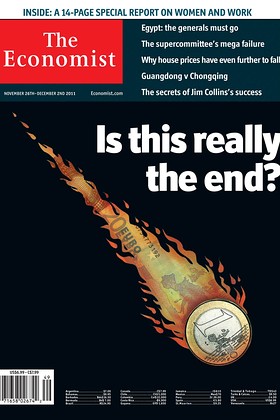Source: MarketWatch by Jon Friedman Nov. 30, 2011, 12:01 a.m. EST
Commentary: Its digital-only sales have hit 100,000
Yes, it is a lightning rod. Like a lot of other well-known enterprises, it is admired by its fans and widely despised by detractors. They carp that the Economist is overrated, prissy and dogmatic.
The critics demean the Economist by saying that much of its popularity in America stems from people who want to look smarter than they really are. That’s the price of success.
Nevertheless, if you happen to work for an American magazine company these days, chances are good that the Economist is eating your lunch.
The proof is in the numbers. This week, the Economist announced that digital-only sales of the magazine hit 100,000 for the first time, complementing growth on the print side.

The Economist
The Economist’s Paul Rossi.
The Economist’s executives cited long-term investments in editorial content and digital distribution, underscoring a conviction that the tablet revolution in electronic publishing are significantly changing the behavior of magazine readers.
“If you go back a year,” Paul Rossi, the managing director and executive vice president of the Economist Group, Americas, told me, “we didn’t have any kind of a firm opinion of how readers’ habits were going to change. The iPad is the perfect device (for readers). One in four of the Economist’s readers owns one and (another) one in four will own one in a year’s time.”
Readers embrace tablets because the instruments “offer huge advances in giving the reader what he wants when he wants it. Many people who are now taking digital subscriptions were historically not print subscribers,” Rossi pointed out, obviously pleased by this development.
The milestone, reached in October, of 100,000-plus paid digital-only circulation of the Economist, was more than double the figure 12 months earlier. In addition, another several hundreds of thousands of print subscribers also read it digitally each week.

The Economist
A recent Economist cover
The Economist also boasts more than three million downloads of the Economist app to tablets and smartphones.
The magazine has seen an increase in sales of print copies, as the print circulation has grown by 3% to 1,486,838 copies in the January-to-June 2011 ABC audit period, compared with the same span a year ago.
The Economist is not exactly reinventing the wheel, I understand. You don’t have to be a rocket scientist to become successful in digital publishing
— and it sure helps to be peddling a magazine that the public has already anointed as being somehow hip.
Nor is the Economist the biggest-selling magazine in the U.S. But it’s established itself as being a tastemaker, whether its cover headlines are breezy or blunt. Many editors have openly expressed admiration for its style.
Much of the Economist’s success is simply based on applying your strength in an adventurous manner to the digital medium. “We have a site where people can build a community around the economic commentary,” Rossi said.
The Economist has experienced a jump in the number of monthly visitors online with more than seven million unique monthly users, up 45% from a year earlier.
I asked Rossi to describe what he thinks it takes to be a winner in digital publishing today.
Predictably, Rossi’s response was concise and illuminating. It gave me an insight into how a successful brand approaches a challenge. It identifies an opportunity and applies a workable solution to fill a need in the marketplace.
“The winners will be the people who understand that the readers’ tastes are changing,” Rossi shot back.
In a press release, the Economist Group’s chief executive Andrew Rashbass, said: “We are discovering great opportunities in digital. Digital editions of the Economist reach new readers all around the world as well as providing even more value to our current subscribers. For us…digital is not a zero-sum game.”
Clearly, the sun never sets on the Economist’s empire.
FOOTNOTE: MyCMO views The Economist as the closest thing to a bible for world new and insights. Digital and Print can work together for a brand and the business can profit. Publishers who do not “get it” have written their own obituaries in YESTERDAY’S news.

